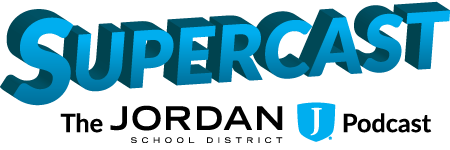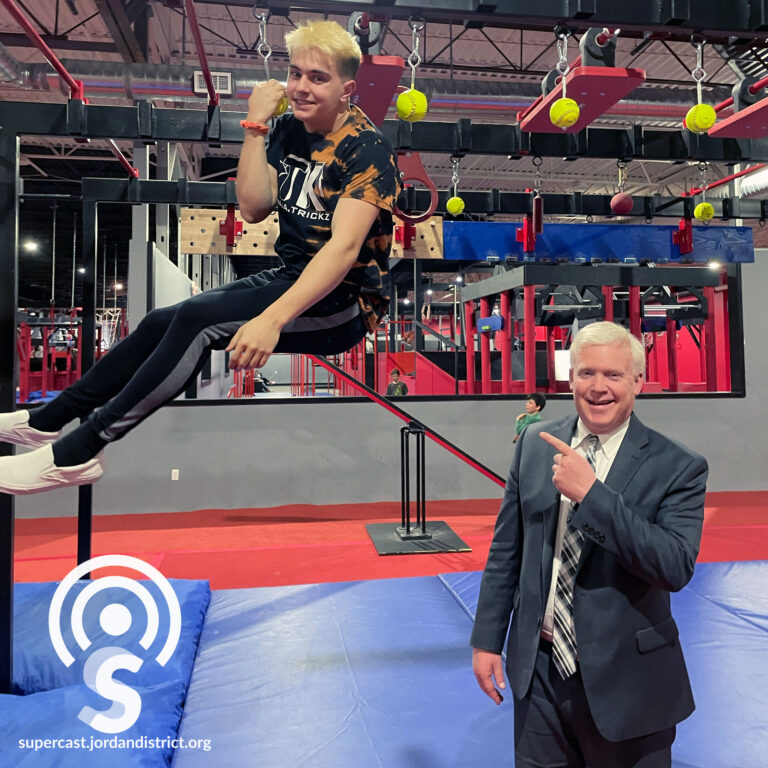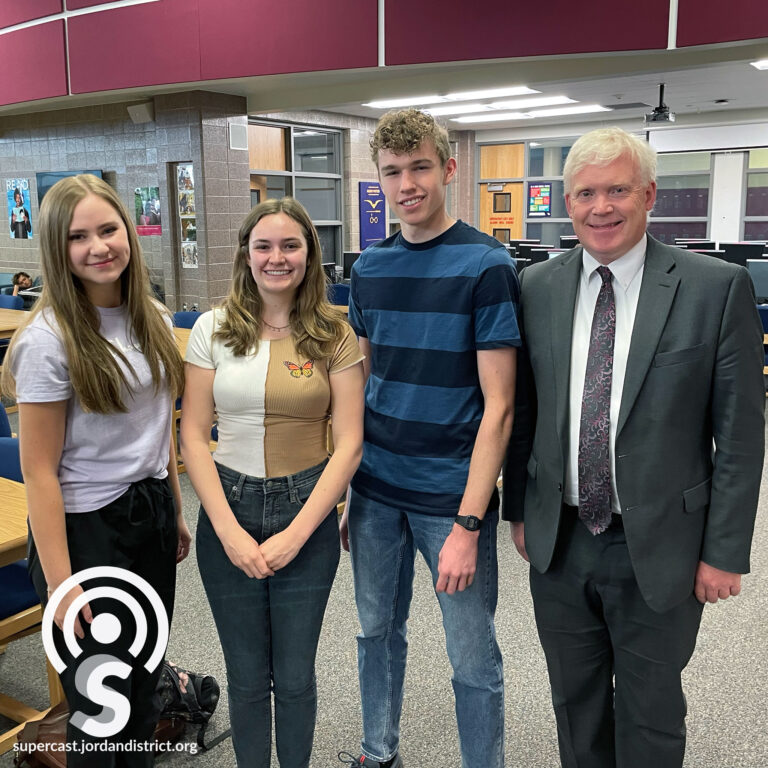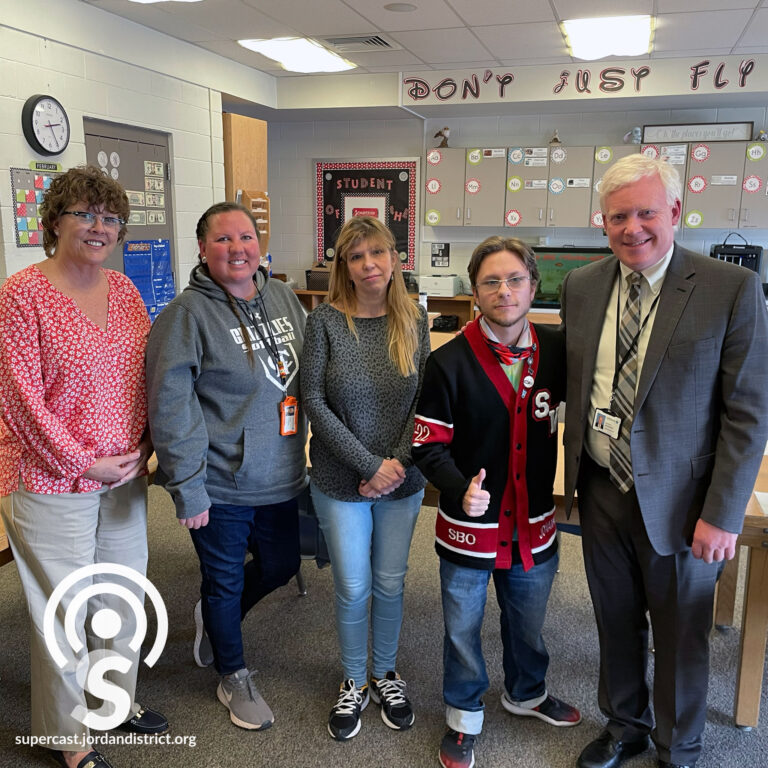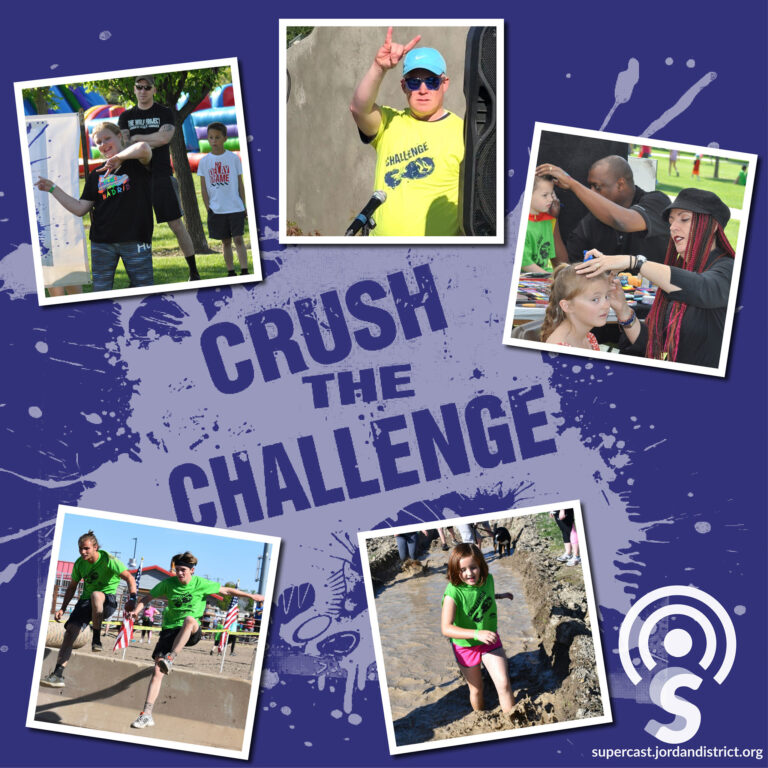He will be running up warped walls, attempting notoriously difficult rope climbing and racing through gravity-defying obstacle courses.
On this episode of the Supercast we head to the gym with Mountian Ridge High School senior Tyler Kurtzhals. Tyler is training to become the next American Ninja Warrior on the TV show which premieres on Monday, June 6. Find out what it takes to make it as an elite athlete in an extremely difficult and demanding sport.
Audio Transcription
Anthony Godfrey:
Hello, and welcome to the Supercast. I'm your host, Superintendent Anthony Godfrey. He will be running up warped walls, attempting notoriously difficult rope climbing, and racing through gravity defying obstacle courses. On this episode of the Supercast, we head to the gym with Mountain Ridge High School senior Tyler Kurtzhals. Tyler is training to become the next American Ninja Warrior on the TV show, which premieres on Monday, June 6th. Find out what it takes to make it as an elite athlete in an extremely difficult and demanding sport.
We are here at the Impact Ninja Gym with Tyler Kurtzhals talking about his American Ninja Warrior quest. Tyler, thanks for taking time with us.
Tyler Kurtzhals:
Yeah, thanks for having me.
Anthony Godfrey:
So you're a student at Mountain Ridge.
Tyler Kurtzhals:
Yep.
Anthony Godfrey:
What year are you?
Tyler Kurtzhals:
I’m a senior.
Anthony Godfrey:
So you're a senior at Mountain Ridge and I know you've been an American Ninja Warrior fan for a long time. Tell me about when you started watching and what got you interested in this. And then I want to talk about what's ahead for you.
Tyler Kurtzhals:
So I got interested when I was eight years old. I was just scrolling through the recorded list of TV shows on TV and my mom had recorded this show called American Ninja Warrior. It was just a super cool, giant playground to me at the time. As a kid, I would climb on just about anything you could think of: trees, hallways, doors. I would climb on doors. And it just looked so much fun. It was like a giant playground for adults with extreme obstacles. And I was hooked from age eight and started competing when I was about 14 years old.
Anthony Godfrey:
Now we've been watching it as a family. My two boys really like it. We've watched it for years as well. And it is a lot of fun to watch and cheer for certain people. So can you describe a little bit more to those who may not have watched American Ninja Warrior, what it involves?
Tyler Kurtzhals:
So, American Ninja Warrior is an obstacle course TV show. It starts with a qualifying round where they call about 500 participants to a certain city and then they film five separate qualifiers. Out of each qualifier, the top 30 go to another city for the semifinals. And then out of each semifinal, the top 15 advance to the National Finals in Las Vegas, where there are four obstacle courses. And if you complete all four stages, you can win a million dollars.
Anthony Godfrey:
Who is your favorite American Ninja Warrior? Would you say?
Tyler Kurtzhals:
I think one of my favorites is probably Daniel Gil.
Anthony Godfrey:
I remember Daniel.
Tyler Kurtzhals:
Yeah. He's got really long hair. He's a worship leader from Houston, Texas. He's just really inspiring because he like, he's a man of the people. He's really close to his community. He was really uplifting. He's a super nice guy. And plus he's one heck of a Ninja too. I mean he's scaled the Mega Wall, which is an 18 foot version of the warped wall. If you get it in one try you get $10,000 and I'm gonna be trying to follow in his footsteps later this year. I'm gonna try to go for it if I get there.
Anthony Godfrey:
So let's talk some more about you as a fan before we talk about you as a competitor. Now I seem to recall that you have attended some of the American Ninja Warrior competitions, maybe in Las Vegas? Is that right?
Tyler Kurtzhals:
Yeah. I've been to Vegas to watch the filming three times and I've been to one of the qualifying filmings once.
Anthony Godfrey:
Now I have to ask this because as I watched it, I saw that there's a pretty small crowd at those events or it seems that way. How did you get to be part of the crowd? Did you have to sleep out and camp out to get in line or how did that work?
Tyler Kurtzhals:
There's this website, it's called On Camera Audiences and they basically distribute tickets for all sorts of TV shows like America's Got Talent, Wipe Out, American Ninja Warrior. And basically the tickets are pretty much free, they're like first come first serve though.
Anthony Godfrey:
So, you get a free ticket, but then you have to be there and show up and be one of the first people there in order to get something out of it.
Tyler Kurtzhals:
Yeah, exactly.
Anthony Godfrey:
Okay, so tell me about your path to being a competitor.
Tyler Kurtzhals:
So, when I was younger, I didn't know exactly that there were, there's actually a lot of like local leagues and stuff with Ninja, like all across the nation. I had no idea. So the first comp I actually did was the junior TV show. So there's another TV show called American Ninja Warrior Junior. Where it's two side by side courses and kids are brought on, ages 9 to 14, and they race. First one to the end wins.
Anthony Godfrey:
Now the adult competition is timed.
Tyler Kurtzhals:
Yeah.
Anthony Godfrey:
So that there's only one person on the course at a time. And then you compare times with each other.
Tyler Kurtzhals:
Yep.
Anthony Godfrey:
But it was side by side competition for the youth league?
Tyler Kurtzhals:
Yes.
Anthony Godfrey:
Okay. And, so when did you first compete in that?
Tyler Kurtzhals:
2018. I was 14 years old. I applied for it having no real idea if I was gonna get on or not. And then probably April of that year, I found out I was gonna get on it. And then I did my best to train for it. I hadn't been to a Ninja gym very much beforehand. So that ended up being my first experience competing. And that really opened me up to a lot of the leagues all over the place. And I was able to go spread my name a lot more.
Anthony Godfrey:
So where all have you competed?
Tyler Kurtzhals:
Just about everywhere you can think of really. The furthest I think I've gone, was probably Florida or Connecticut.
Anthony Godfrey:
Okay. Wow.
Tyler Kurtzhals:
I’ve gone all the way to the East Coast to compete, gone to probably all four corners of the country.
Anthony Godfrey:
And you have a competition coming up soon. Tell us about that.
Tyler Kurtzhals:
Yeah. I'm actually competing on Season 14 of American Ninja Warrior next week.
Anthony Godfrey:
Wow. That's amazing. That's really cool. So when will that air?
Tyler Kurtzhals:
Probably sometime in June, they haven't announced airing dates yet. But it films all next week for qualifying. And then if I keep doing well, I'll keep advancing and going to more filmings to try to get further and further into the competition.
Anthony Godfrey:
So this isn't junior.
Tyler Kurtzhals:
Nope.
Anthony Godfrey:
This is just the straight up competition.
Tyler Kurtzhals:
This is the big show.
Anthony Godfrey:
Wow. That's pretty amazing. Now, as I watched the show, there were some people who talked about camping out to try to get on. Is that kind of like a wild card option that people have to get on? That's a different path from yours, right?
Tyler Kurtzhals:
Yeah, it used to be before COVID they would allow it, but it was called the walk on line.
Anthony Godfrey:
Oh, okay.
Tyler Kurtzhals:
So people who didn't get accepted would wait up to like a full month in a line outside of the set. Just to get a shot to compete.
Anthony Godfrey:
Yeah. But you've built your name up and you're able to just get on the show.
Tyler Kurtzhals:
Yeah. So the other way to get on the show is the application. So it's like eight pages of like questions and stuff. And then you have to submit a two to three minute video explaining.
Anthony Godfrey:
I remember watching the videos about ‘I'm doing this for my father and he watched me train’ and that sort of thing.
Tyler Kurtzhals:
Yeah.
Anthony Godfrey:
There were kinda some heartfelt, touching stories about how people are overcoming adversity in their lives to be able to be part of it.
Tyler Kurtzhals:
Yeah, basically tell them your story. And if they're interested in you and want to do a bigger scoop on you, then you've got a really good shot of getting on the show.
Anthony Godfrey:
But you've gone through more the competitive path to show that you're a real competitor and someone who can advance.
Tyler Kurtzhals:
Yes.
Anthony Godfrey:
Okay. Stay with us. When we come back more with Tyler and we talk to his mom about supporting her Ninja Warrior son through the highs and lows of competition.
Break:
Do you simply love learning online? We can't wait to have you join the amazing teachers in our brand new Jordan Virtual Learning Academy. In Jordan Virtual Learning Academy schools, we offer innovative, fun, and flexible online learning with daily real-time instruction from teachers. Enrollment is currently open for all K-12 students in Utah. Start on the path to personalized virtual learning success now at connect.jordandistrict.org. That's connect.jordandistrict.org.
Anthony Godfrey:
As someone who's watched the show, I'm very interested to hear more behind the scenes about how you've prepared. So, we're here at the gym, as you can hear in the background. And there are all kinds of contraptions here that really, to me look more like they're designed for torture than exercise. But fortunately for you, I suspect they look like fun. So, can you show me some of the exercises that you've gone through to prepare?
Tyler Kurtzhals:
Yeah, sure.
Anthony Godfrey:
Let's describe what you're gonna do and then let's see.
Tyler Kurtzhals:
So typically the first round will have like six obstacles. Three of them tend to be upper body and then three of them are lower body and it always ends with the warped wall, which is this big ramp.
Anthony Godfrey:
Here's the warped wall. Tell me about your technique for the warped wall.
Tyler Kurtzhals:
So the best technique for the warped wall is to plan out your steps. Usually on the show, they allow about 10 feet of run up before the wall. So like probably that's where I'm standing now. And usually when I get to the foot of the wall, I try to look up and find the bar on top. And then cuz usually your body is gonna follow wherever you're looking. So if I find the bar, my body's just gonna go straight up.
Anthony Godfrey:
So the lesson here is look. You have to keep your eye on your goal.
Tyler Kurtzhals:
Yeah.
Anthony Godfrey:
In order to get there.
Tyler Kurtzhals:
Look where you wanna get to.
Anthony Godfrey:
So for, for those who are listening, it's a very, very steep ramp that he's trying to run up. And by steep, I mean like 90 degrees in the air ramp and then he's gotta grab a bar at the top and pull himself up. And how high is the wall?
Tyler Kurtzhals:
This one's 14 feet. The one on the show is 14 1/2 feet. And then they also have the Mega Wall, which is 18 feet.
Anthony Godfrey:
And that's the one where if you scale it, you get $10,000 on the first try.
Tyler Kurtzhals:
Yep.
Anthony Godfrey:
Okay. Well, are you ready to show me what you've got on this?
Tyler Kurtzhals:
Sure.
Anthony Godfrey:
All right. How many times, before we do this, before you do this. Let's be clear, it's you doing this.
Tyler Kurtzhals:
Yeah.
Anthony Godfrey:
How many times have you scaled the wall like this would you say?
Tyler Kurtzhals:
Way more than I could count honestly. They're in just about every competition that I do.
Anthony Godfrey:
Alright. Let's see.
Anthony Godfrey:
My gosh. You just leapt up there. It's like nothing.
Tyler Kurtzhals:
Yep.
Anthony Godfrey:
I don't mean to suggest that it's easy, but you make it look easy. Holy cow.
Tyler Kurtzhals:
It gets easy after a while.
Anthony Godfrey:
Wow. That's a tough one because it takes some precision.
Oh my heavens. You skipped, you just went every other hook. That was quickly done. Oh my Gosh. I really can't get over how fast you've scaled up that.
Tyler Kurtzhals:
Thanks.
Anthony Godfrey:
That is something. So is this like in the competition?
Tyler Kurtzhals:
So this one's actually a little bit different than the competition. So, on the show, the gaps between the rungs are a foot, 12 inches, and these gaps are 8 inches. That's why I was skipping that.
Anthony Godfrey:
So that's why you doubled up, but that's still farther than you're going to have to go in competition.
Tyler Kurtzhals:
Yeah. We have another salmon ladder over there that's the right size.
Anthony Godfrey:
I see. Now, I just kind of can't get over how fast you can do that. What is your persona? What is your name? Your character, or are you just you? What's your outfit? I mean, what's your look for the show?
Tyler Kurtzhals:
So, mostly what I'm wearing right now is actually what I'm gonna be competing in. I’ll have different shoes because these aren't really competition shoes. But my nickname in Ninja is TK Ninja Tricks. It's basically for all the stupid, like tricks that I'll do at comps. Like for example, in my last comp I made a really good save on an obstacle and I ran off the platform and did a flip.
Anthony Godfrey:
Oh wow. So do kids at school know about this and your friends know about this, I assume. And what do they think of your being an American Ninja Warrior?
Tyler Kurtzhals:
They think it's pretty cool. It's a really unique thing. There's not a lot of Ninjas out here. And they think it's really cool to see someone just going after their dream at school. I feel like a lot of people don't really follow their dream very much. They have a really big dream in their head and then kind of just set it aside for like money or something they think will make them happy or something like that. So it feels really cool. It gives me a really good sense of power and makes me feel like I'm inspiring a community a lot. And most of the people at school think it's awesome.
Anthony Godfrey:
Well, I think it's fantastic and I love that you have dedicated the time and effort that you have to making your dream come true. Tell me what kind of practice schedule you have.
Tyler Kurtzhals:
So right now I train about four days a week, usually for two hours per training session. Basically each day is kind of separated into different disciplines in Ninja. Like one of the days is balance. Another day is strict upper body like holding a lock off. A lock off is like where you hang with your arm bent, whether it's off of one arm or off of both arms. Or I'll do like technique or just like power, like training certain moves, like bigger throws. Usually I'll run 'em all in courses together. Like I'll compile all the obstacles together and run probably 10 obstacles in one course and just have fun.
Anthony Godfrey:
All right. Let's talk with your mom Stacy about what it's like to be a Ninja Mom. Tell me about your part of this journey.
Stacy Kurthzhals:
It requires a lot of dedication to travel. There's not a lot of competitions locally, so they’re a lot more on the east coast than there is out here. So we get a lot of frequent flyer miles cause we have to fly back and forth quite often. Initially for him there wasn't anybody to train him. So that was really hard because there was nobody that did it out here. There were actually no gyms when he started. So he kind of trained himself, but then finding places and getting him more access to things has been, you know, one of those things we've had to do.
Anthony Godfrey:
Did you kind of know early on like ‘yeah, this is gonna take hold. This is what he's gonna do.’
Stacy Kurthzhals:
Yeah. He had some really natural skills at it. And as we started getting him into competitions and seeing what he did compared to people who had actually trained, we knew that he was actually really good at this and I've never seen a kid at 12 years old who put their heart and soul into training and never quit. And that was something that he's just really dedicated to it.
Anthony Godfrey:
It's really impressive. Just talking to him, it's very clear how much he loves this and how much he has dedicated himself to it.
Stacy Kurthzhals:
Absolutely.
Anthony Godfrey:
Is it hard to watch as mom? Does it make you nervous? Or have you developed the same cool, collected, demeanor that your son has?
Stacy Kurthzhals:
It depends on which kind of competition it is. If it's a local competition, I don't worry. Not a big deal. When he gets into some of the bigger ones that he does, I definitely get the nerves. It's not about his ability. It's more of, he wants this so bad and he gets one shot. And so I don't wanna see him disappointed for any reason.
Anthony Godfrey:
Well, that's the difficult thing when I watch. And when I even think about watching you, Tyler is that there's no margin for error. It's not like basketball where you can miss all kinds of shots and still have an amazing game. You miss and it ends.
Stacy Kurthzhals:
One shot.
Tyler Kurtzhals:
That’s the name of the game.
Anthony Godfrey:
That's the name of the game. All right. Thank you so much for taking the time to talk with me. I'm really excited to watch you in this competition. I can't wait. And I'm really proud of the work you've done. It's really exciting to see everything you've put into this. And I really like your chances.
Tyler Kurthzhals:
Yeah. Thanks for having me. That means a lot.
Anthony Godfrey:
And Stacy, thanks for letting us come and talk with you guys and good luck on your part of the journey as well.
Stacy Kurthzhals:
Thanks. The mom nerves will be there, but I'll be okay.
Tyler Kurtzhals:
Oh, she's gonna be louder than the whole audience in the entire crowd.
Anthony Godfrey:
I bet she will.
Tyler Kurthzhals:
She is the loudest fan ever.
Anthony Godfrey:
I love that. And now I'm remembering that there's a part kind of before and after where they say here's mom watching and they show, you know, holding your hands, like, oh my goodness, shaking and yelling. And so I look forward to watching that as well.
Stacy Kurtzhals:
You'll probably hear me all the way here in Utah.
Anthony Godfrey:
That's good, that's good.
Thanks for joining us on another episode of the Supercast. Remember education is the most important thing you'll do today. We'll see you out there.
